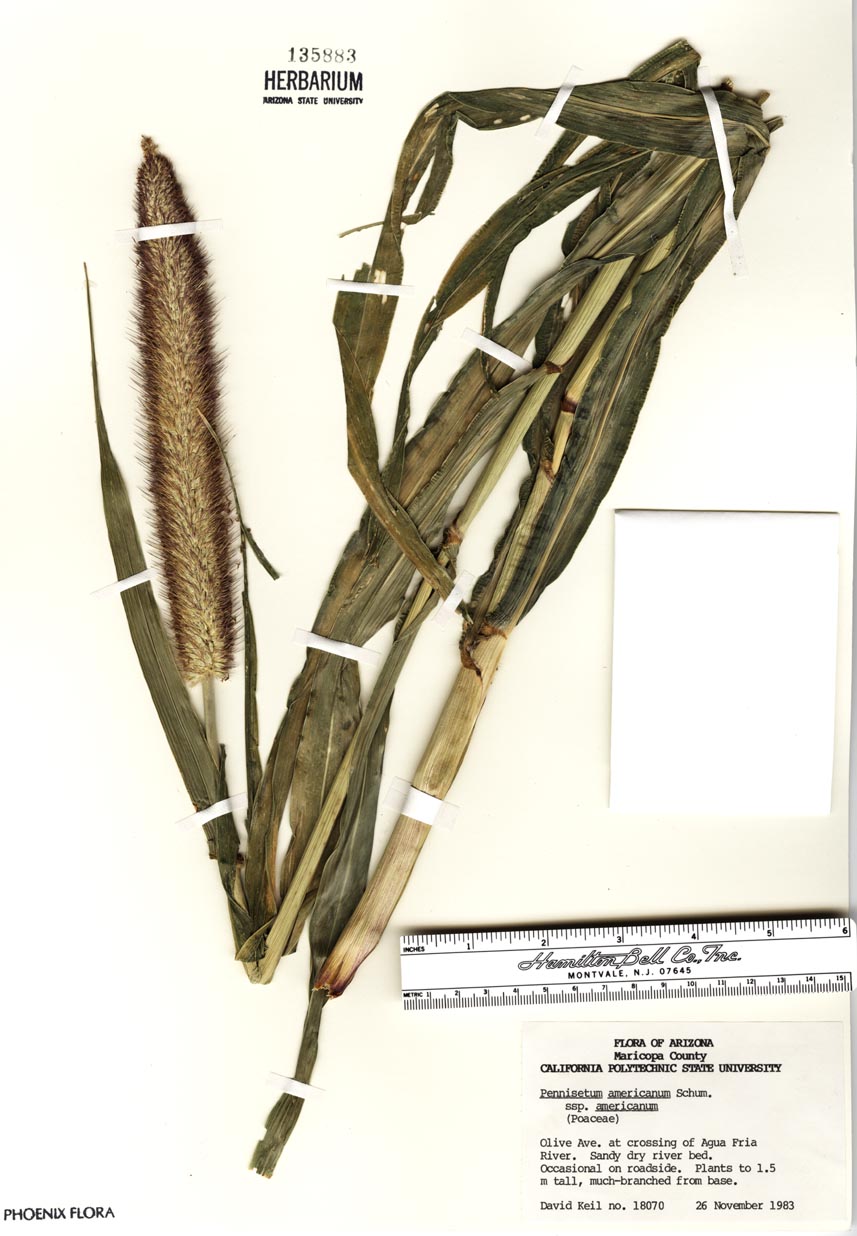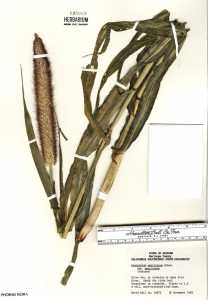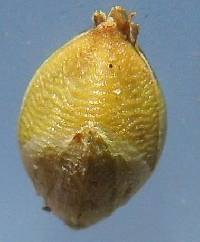Plants annual. Culms 50-300 cm, erect, branching; nodes glabrous. Sheaths glabrous or pubescent, with or without ciliate margins; ligules 2-5 mm; blades 15-100 cm long, 7-70 mm wide, flat, glabrous or pubescent. Panicles terminal, 4-200 cm long, 2-70 mm wide, fully exerted from the sheaths, erect; rachises terete, densely pubescent. Fascicles 33-160 per cm; fascicle axes 1-28 mm, persistent, with 1-9 spikelets; outer bristles 44-131, 0.5-6 mm; inner bristles 6-19, 4-6 mm, plumose; primary bristles 5.5-6.3, ciliate, sometimes noticeably longer than the other bristles. Spikelets 3-7 mm; pedicels 0.6-1.8 mm; lower glumes absent or to 1.5 mm, veinless; upper glumes 0.5-3.5 mm, 3-5-veined; lower florets staminate or sterile; lower lemmas 1.5-6 mm, glabrous, 3-7-veined, margins ciliate; lower paleas vestigial or fully developed, margins ciliate; anthers 2.2-2.5 mm, penicillate; upper florets coriaceous, shiny; upper lemmas 4.3-7 mm, 5-7(9)-veined, margins ciliate; upper paleas 3.4-3.9 mm, pubescent, at least near the base, margins ciliate; anthers 2-2.2 mm, penicillate. Caryopses 2-5.5 mm long, 1.6-3.2 mm wide, protruding from the lemma and palea at maturity. 2n = 14.
Pennisetum glaucum, a native of Asia, is cultivated in the United States for grain, forage, and birdseed. It is the most drought tolerant of the tropical cereal crops. Under favorable conditions, 10,000-30,000+ fascicles may be produced. In the Flora region, it is used for soil stabilization, partly because it seldom persists for more than 1-2 years.
Annual herb 0.5 - 3 m tall
Leaves: alternate, two-ranked. Sheaths sometimes hairy. Ligules 2 - 5 mm long. Blades 15 cm - 1 m long, 0.5 - 7 cm wide, lance-shaped, flat, sometimes hairy, parallel-veined.
Inflorescence: a spike-like arrangement (panicle) of reduced branches called fascicles, terminal, upright, 4 cm - 2 m long, 2 mm - 7 cm wide, with a densely hairy axis. Fascicles 33 to 160 per centimeter, with numerous bristles and one to nine spikelets.
Fruit: a caryopsis, indehiscent, enclosed within the persistent lemma and palea, 2 - 5.5 mm long, 1.5 - 3 mm wide, protruding from the lemma and palea at maturity.
Culm: upright, branched, 0.5 - 3 m long, round in cross-section.
Spikelets: short-stalked, 3 - 7 mm long.
Florets: two per spikelet. Lower florets sterile or male. Upper florets shiny and leather-like. Anthers three. Stigmas red.
Glumes:: Lower glumes (if present) to 1.5 mm long, shorter than upper glumes, membranous, lacking veins. Upper glumes 0.5 - 3.5 mm long, longer than lower glumes, three- to five-veined.
Lemmas:: Lower lemmas 1.5 - 6 mm long, equal to spikelets, three- to seven-veined, membranous, marginally fringed with hairs. Upper lemmas 4.5 - 7 mm long, five- to seven-veined, marginally fringed with hairs.
Paleas:: Lower paleas rudimentary or well-developed, marginally fringed with hairs. Upper paleas 3.5 - 4 mm long, paleas shorter than lemmas, similar in texture to lemmas, hairy (at least basally), marginally fringed with hairs.
Similar species: No information at this time.
Habitat and ecology: Native to Asia, cultivated for grain, forage, and birdseed. Very drought tolerant, often used for soil stabilization
Occurence in the Chicago region: non-native
Etymology: Pennisetum comes from the Latin words penna, meaning feather, and seta, meaning bristle, referring to feathery bristles of some species. Glaucum means glaucous (covered by a white or pale, often waxy, bloom).
Author: The Morton Arboretum
Common Name: pearl millet
Duration: Annual
Nativity: Non-Native
Lifeform: Graminoid
General: Annual with stems 50-300 cm, erect, branching, with glabrous nodes, sheaths glabrous to pubescent, with or without ciliate margins.
Vegetative: Blades 15-100 cm long, 7-70 mm wide, flat, glabrous or pubescent, ligules 2-5 mm densely ciliate.
Inflorescence: Terminal panicles 4-200 cm long, 2-70 mm wide, fully exserted from the sheaths, erect, terete rachises, densely pubescent with 33-160 fascicles per cm, with fascicle axes 1-3 mm, persistent with 1-9 plano-convex spikelets,; bristles irregular, plumose bristles, inner ones 4-6 mm, primary bristles 5.5-6.5 mm, ciliate, sometimes noticeably longer than other bristles, first glume 1-2 mm long, broadly ovate, mucronate, 3-nerved, second glume 1.5-2 mm long, ovate, scarious margins; caryopsis plano convex.
Ecology: Found in disturbed sites, along roadways, or under cultivation; flowers July-September.
Distribution: Originally cultivated in Africa and now spread throughout the world on every continent; throughout the US in every state.
Notes: Cultivated in the US for grain, birdseed and forage. Look for terminal spikes with of fascicles with 1-12 spikelets and 6 or more bristles subtending spikelets, the conspicuously ciliate bristles below spikelets and fascicles not disarticulating from rachises and the caryopsis protruding from florets at maturity.
Ethnobotany: Rubbed on the face to fight pimples. The common name is -pearl millet- and this is the most widely grown type of millet. It has been cultivated in Africa for centuries.
Etymology: Pennisetum comes from Latin penna for feather and seta for bristle, while glaucum means bluish gray.
Synonyms: Panicum americanum, Pennisetum americanum, Pennisetum typhoides
Editor: SBuckley 2010, FSCoburn 2015
Annual 3-13 dm, usually erect, often in large tufts; sheaths glabrous; blades loosely twisted, to 30 cm, 4-10 mm wide, scabrous above and with long papillose hairs near the throat, glabrous beneath; infl stiffly erect, cylindric, (3-)5-10(-15) cm, yellowish, the axis hispid; bristles 4-12 below each spikelet, 3-8 mm, antrorsely scabrous; spikelets 3-3.5 mm; first glume 3-veined, a third as long as the spikelet, the second 5-veined, half as long as the spikelet; sterile lemma about equaling the fertile one, clasping a broad hyaline palea of equal length, sometimes staminate; fertile lemma transversely strongly rugulose; 2n=36, 72. Cult. soil and waste places; native of Europe, now a cosmopolitan weed, and abundant throughout our range. (S. lutescens; S. pumila)
Gleason, Henry A. & Cronquist, Arthur J. 1991. Manual of vascular plants of northeastern United States and adjacent Canada. lxxv + 910 pp.
©The New York Botanical Garden. All rights reserved. Used by permission.








